If you’re living in Virginia and thinking about growing your own fruit trees, you’re in luck! Virginia has a milder climate compared to other states on the eastern coast, making it a great place for a variety of fruit trees. The climate zones here, known as USDA Hardiness Zones, range from 5 to 8.

From peaches to apples to cherries, there are plenty of options that will not only survive but also thrive in your Virginia backyard. So, whether you’re a gardening pro or just getting started, read on to discover the top fruit trees that you can plant in Virginia.
1. Gooseberry Tree (Phyllanthus acidus)
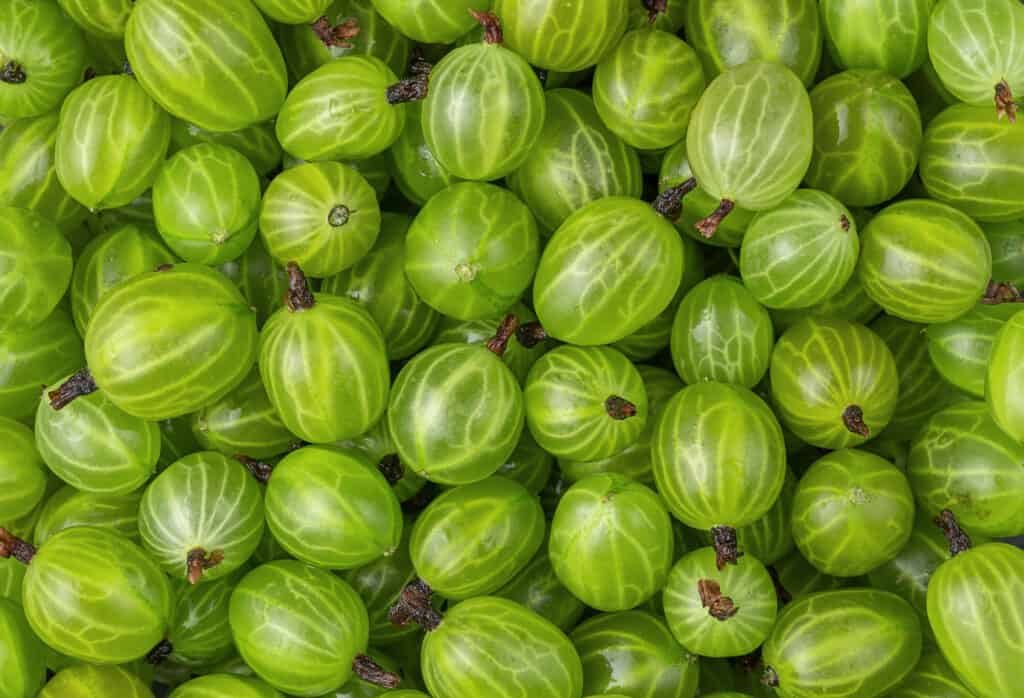
Gooseberries are a unique fruit that have a similar texture and look to grapes, though they are more sour.
©iStock.com/Serhii Tychynskyi
First on the list is the gooseberry tree, perfect for growing anywhere in the state of Virginia since it thrives in USDA hardiness zones 3-8.
Belonging to the family Phyllanthaceae, a gooseberry tree is a compact yet thorny plant that produces delicious fruit. This small shrub or tree showcases dark green leaves with deep lobes, accompanying the bell-shaped flowers it blossoms. The fruits it yields are colorful, ranging from green and yellow to red, each containing numerous minuscule seeds within their one-inch bodies.
This fruit tree is moderate in size typically growing to a maximum height of 6 to 8 feet and spreading about half as wide.
Gooseberry trees are resilient, rugged plants, and can adapt to a variety of places. Although they can endure a range of soil conditions, they are particularly fond of well-drained, damp soils. If you’re limited on space, they also thrive in spacious pots or containers. Ideally situated in sunny locales for optimal fruit sweetness, they can also withstand partial shade.
2. Mulberry Tree (Morus)

Living up to 50 years and producing fruit after about 8 years of growth, mulberry trees are wonderful fruit trees to grow.
©Roman Kutsekon/Shutterstock.com
The mulberry tree feels quite at home in Virginia, especially the native variety, known as the red mulberry or Morus rubra. Perfectly suited to zones 5 to 8, this tree was destined to flourish in the Virginia landscape.
This tree has a stout and occasionally irregular trunk. Its young branches exhibit hues ranging from brown to rustic orange-brown. Additionally, these trees exhibit an impressive spread, growing to nearly 50 feet tall and up to 45 feet wide. As spring graces the area, these trees come to life with blossoms, followed by a summer bounty of red, black, or white berries.
For optimal growth, mulberries favor soil that is both rich in nutrients and capable of retaining moisture yet well-draining. Incorporating well-decomposed manure or garden compost can enrich the soil substantially. When selecting a planting location, opt for a sun-kissed, protected area that allows the tree ample space to spread its extensive canopy.
Preferred varieties include white, exotic Himalayan, red, and dark black mulberries.
3. Elderberry Tree (Sambucus)
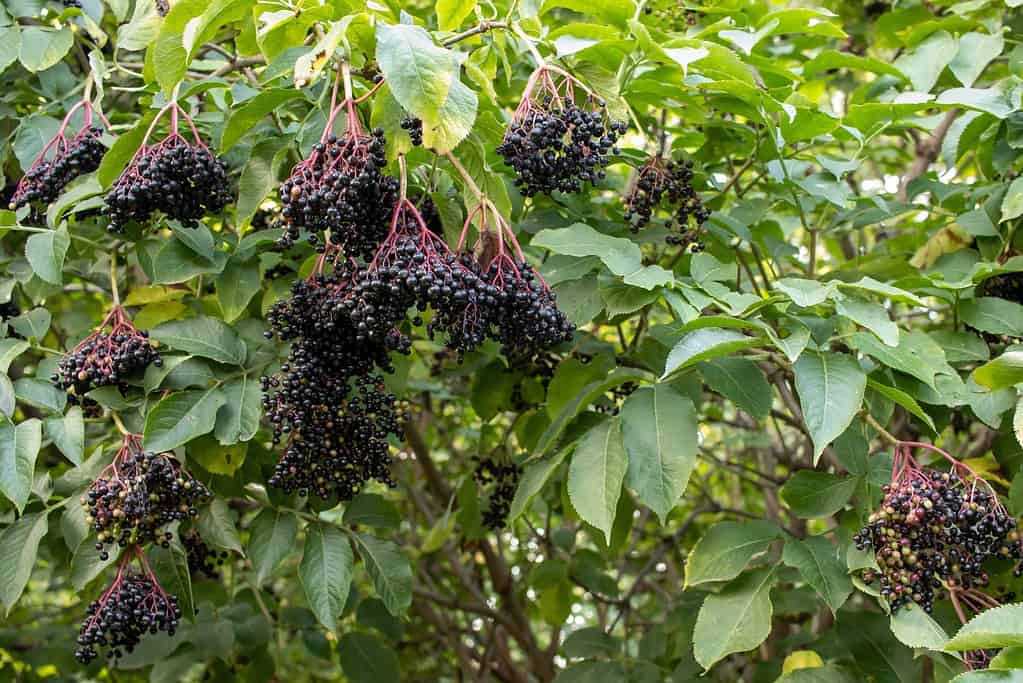
While you can cook elderberries to be eaten in jams or pies, they are toxic when eaten raw.
©Juver/Shutterstock.com
Elderberries are amazing fruit trees that naturally thrive in Virginia, making them an easy option to grow in your yard.
This cherished yet ancient tree is quite petite in stature, generally not exceeding heights of 10 feet and spreading to a maximum width of about 6 feet. Not only are the blossoms and berries from the elderberry tree delightfully aromatic and edible, but with the right preparation, you can transform them into delicious recipes.
However, caution is necessary since elderberries, along with their leaves, bark, and seeds, contain substances that can induce severe illness. Therefore, cooking the berries sufficiently is essential to neutralize the harmful components.
Elderberry trees favor fertile, damp, yet well-draining soils, although they are adaptable to various environmental conditions. It’s advisable to plant them in locations where they can bask in a minimum of 8 hours of direct sunlight during the early summer months, typically from late June to early August, to encourage abundant fruit yield.
4. Persimmon Tree (Diospyros virginiana)
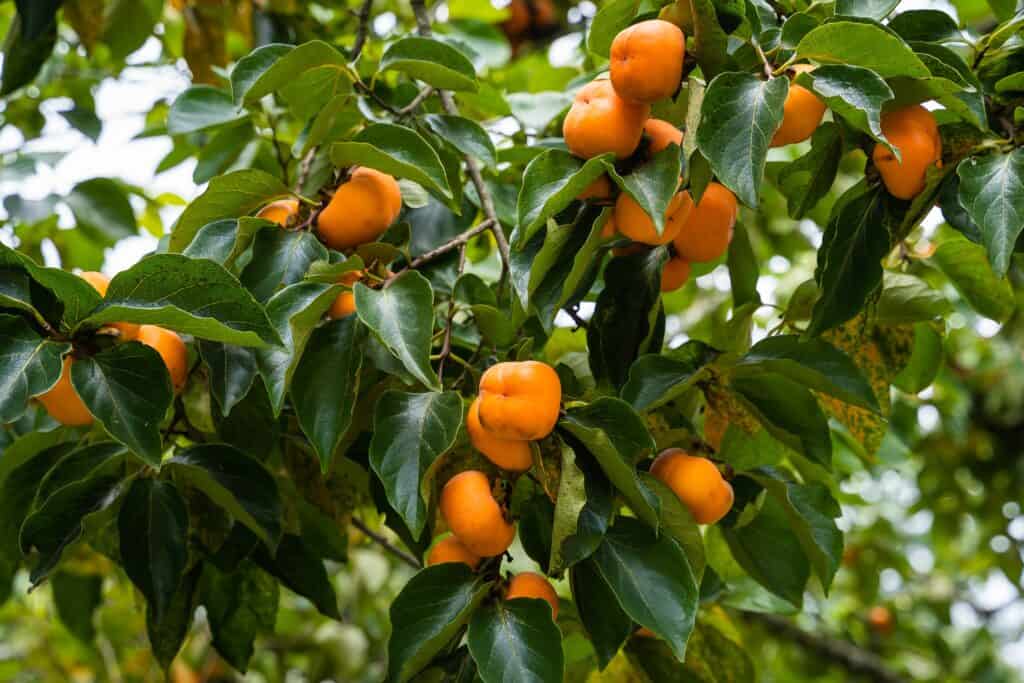
Persimmon trees can live for up to 75 years and will produce lots of fruit for most of their life.
©Supermop/Shutterstock.com
The American persimmon is yet another fruit tree that thrives naturally in many parts of Virginia.
This persimmon tree is a leaf-shedding type, revered for its splendid leaves and palatable fruit, and it holds a special place in gardens for its aesthetic appeal and the hardness of its wood. As late spring unfolds, the tree adorns itself with white, sweet-scented, bell-like blossoms, presenting a breathtaking scene.
While persimmon trees can reach 60 feet, it’s easy to maintain them at a manageable height of under 20 feet, due to their slow growth rate.
We highly recommend planting persimmon trees in areas with partial shade and well-draining soil.
Some popular varieties of persimmon trees include the Hachiya, the exotic Asian variety, the American, and the Virginiana.
5. Pear Tree (Pyrus)

There are many varieties of pear trees in the USA, with most (95%) being grown on the west coast.
©Jennifer Bosvert/Shutterstock.com
Pear trees are suited for hardiness zones 4 to 8, so Virginia boasts weather conditions for these fruit trees.
Identifying pear trees is quite easy. They have a cone-like structure during their initial growth phase, which gradually transforms into a more rounded shape. Pear trees are extremely long living trees, with some living well over 200 years! Typically, a pear tree can reach up to 40 feet in height, spreading out to create a 30-foot wide canopy.
To ensure a bountiful harvest, it’s vital that pear trees receive plenty of sunlight. Regular pruning, conducted yearly, aids in maintaining the tree’s health, enhancing productivity, and preserving its appearance. These trees adapt well to neutral soils with a pH near 7, provided the soil offers good drainage and doesn’t hold standing water.
6. Apricot Tree (Prunus armeniaca)
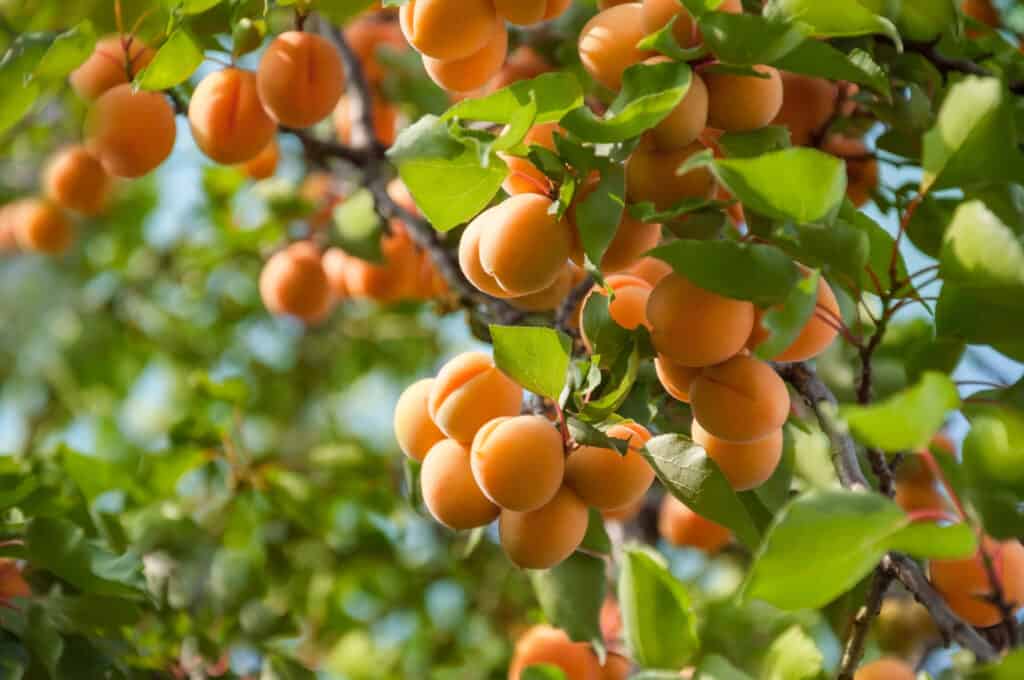
If you love dried, fresh, or cooked apricots, you’ll be happy to know that the trees grow very easily in Virginia.
©iStock.com/Zoya2222
Apricot trees flourish remarkably well amidst Virginia’s warm and humid conditions. These hardy fruit trees can grow in hardiness zones 4 to 9, so the entire state of Virginia poses the ideal conditions.
These trees have rounded leaves that taper to a sharp point. Exhibiting a green color, the leaves stand upright on the branches. While the fruit bears a resemblance to peaches, it distinguishes itself with a mostly smooth skin, adopting round or slightly elongated shapes in various types.
These trees have the potential to grow up to 39 feet tall; however, through regular pruning and upkeep, they are usually kept within a range of 11.5 to 13 feet in height.
For optimal growth, select a sunny, wind-protected location. Given their expansive canopy, apricots require ample room to spread. A standard tree necessitates an area with a diameter of at least 23 feet. If you are planning to plant varieties that facilitate cross-pollination, be cautious not to space them excessively apart. It is important to note that they thrive in fertile, well-draining soil with a substantial depth.
The best apricot varieties to consider for Virginia are Goldbar, Goldstrike, Tomcot, and Rival.
7. Crabapple Tree (Malus)

Crabapple trees are another perfect fruit tree for Virginia.
©Igor Sirbu/Shutterstock.com
Sporting an uneven, spherical structure, they grow a broad, sprawling branch system. The tree’s bark is grayish-brown in color with mottled patterns.
Typically, crabapple trees grow to around 15 to 20 feet in both height and width. Additionally, there are compact versions and semi-compact variations, standing anywhere between under 5 feet to a respectable 10 feet tall.
To witness them in their full glory, ensure they receive a minimum of 6 hours of sunlight daily. Despite favoring nutrient-rich, moist, and well-aerated soils, they exhibit a remarkable ability to adjust to a variety of ground compositions. However, they find it challenging to thrive in dense, waterlogged clay conditions.
While not commonly eaten raw, crabapples are actually a very nutrient-rich fruit that can be enjoyed cooked in pies, sweets, or even eaten raw if you enjoy a tart flavor!
8. Serviceberry Tree (Amelanchier)
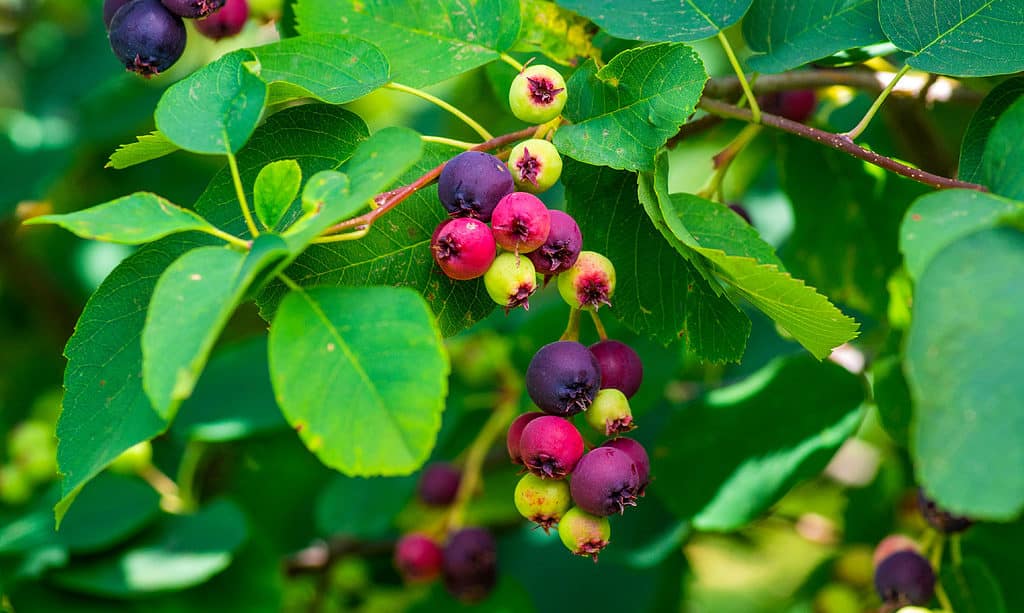
Serviceberry trees can thrive in Virginia as their optimal USDA hardiness zones are 4 to 9.
©Iva Vagnerova/Shutterstock.com
In Virginia, you can discover seven native varieties of serviceberry, establishing it as an ideal fruit tree for the state.
These serviceberries are shedding plants that have simple, alternately set leaves. Generally, their blooms are white and come with five petals; the ending groupings can showcase up to 20 blossoms. They produce small, apple-like fruits that transition from a reddish color to a deep purple as they mature, serving as a favored treat for birds and other local fauna. They are also safe to consume for humans, and many Virginians use serviceberries in jams, baking, and even wine!
Though serviceberries thrive in mildly acidic conditions, they can also endure soils with a neutral pH level. This tree adjusts well to varying levels of sunlight and can grow in both full sun and semi-shaded areas, although a sunnier spot guarantees a more bountiful fruit harvest.
The best varieties of serviceberry trees for Virginia gardens are Allegheny, Downy, Apple, and Shadblow.
9. Cherry Tree (Prunus)
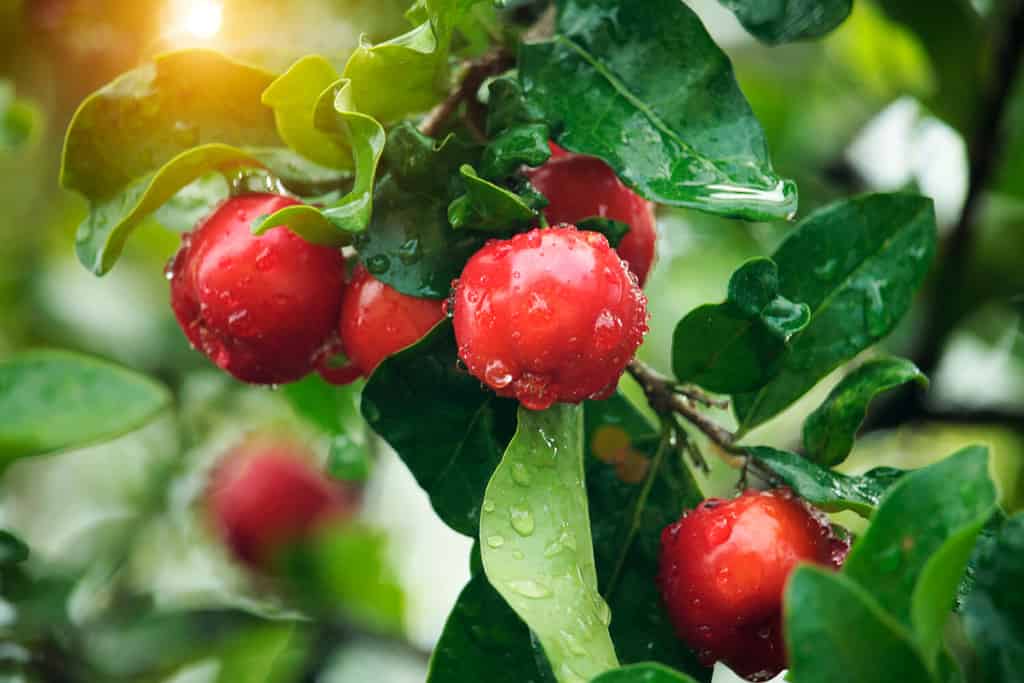
Mature cherry trees can grow up to 100 pounds of cherries per year!
©Mr.Somchai Sukkasem/Shutterstock.com
The cherry tree is perhaps the most famous fruit tree in Virginia due to the myth of George Washington (one of 8 presidents from Virginia) cutting down his father’s tree.
In Virginia, both sweet and sour cherry trees grow, with a majority of the sweet varieties being well-adapted to the local weather conditions.
The wood of cherry trees is excellent for crafting furniture, doors, instruments, and decorations.
The cherries themselves are succulent stone fruits, often appearing heart-shaped or nearly round, with a typical diameter of about an inch. The color spectrum of these fruits ranges from yellow to varying shades of red, even nearing black at times.
Ideally, cherry trees should be planted in spaces like gardens, yards, or orchards where they can bask in uninterrupted sunlight throughout the day and root in rich, well-draining soil teeming with organic matter.
If you want to plant a cherry tree in your Virginia garden, you are spoiled for choice. The top sweet cherry varieties to opt for include Napoleon, Windsor, and Hudson. Meanwhile, for those preferring tart cherries, the Montmorency variant proves to be a superior choice, given its compatibility with Virginia’s climatic conditions.
10. Nectarine (Prunus persica var. nucipersica)
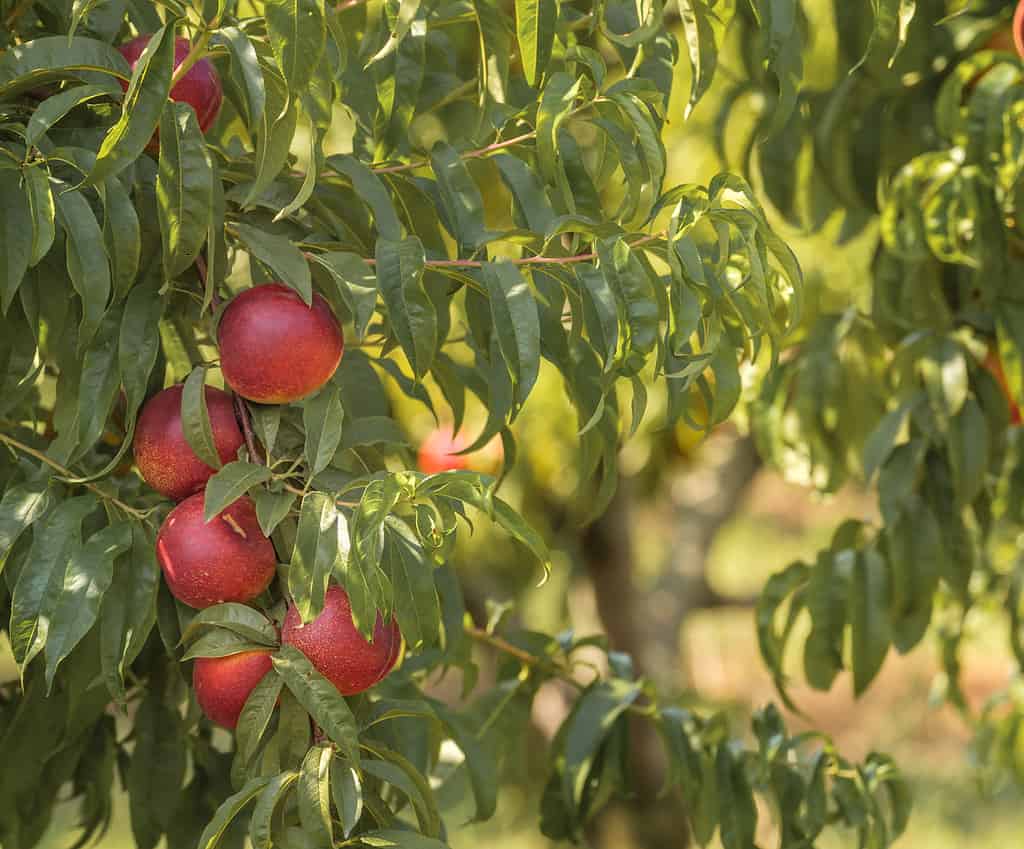
Nectarines are delicious and large fruits resembling peaches without any fuzz.
©IonelV/iStock via Getty Images
The nectarine tree, often referred to as the bare peach tree locally, stands as a favorable option for cultivation in Virginia.
Resembling peaches in both look and flavor, nectarines distinguish themselves with their smooth, fuzz-free exterior. It’s hard to differentiate between a nectarine tree and a peach tree just by looking at them. Generally moderate in size, these trees rarely exceed a height of 21 feet.
Nectarines demand ample sunshine, and their growth should not be hindered by shadows cast from buildings or tall vegetation. Choosing an elevated location for planting is wise, as it allows cold air to flow away from the tree during chilly nights in the blooming season, safeguarding it from potential frost damage. Ideally, the chosen spot should possess well-aerated soil with a sandy loam texture.
For those starting out, varieties like Fantasia, Redgold, or Flavortop are top options that will thrive in the state.
11. Plum Tree (Prunus domestic)
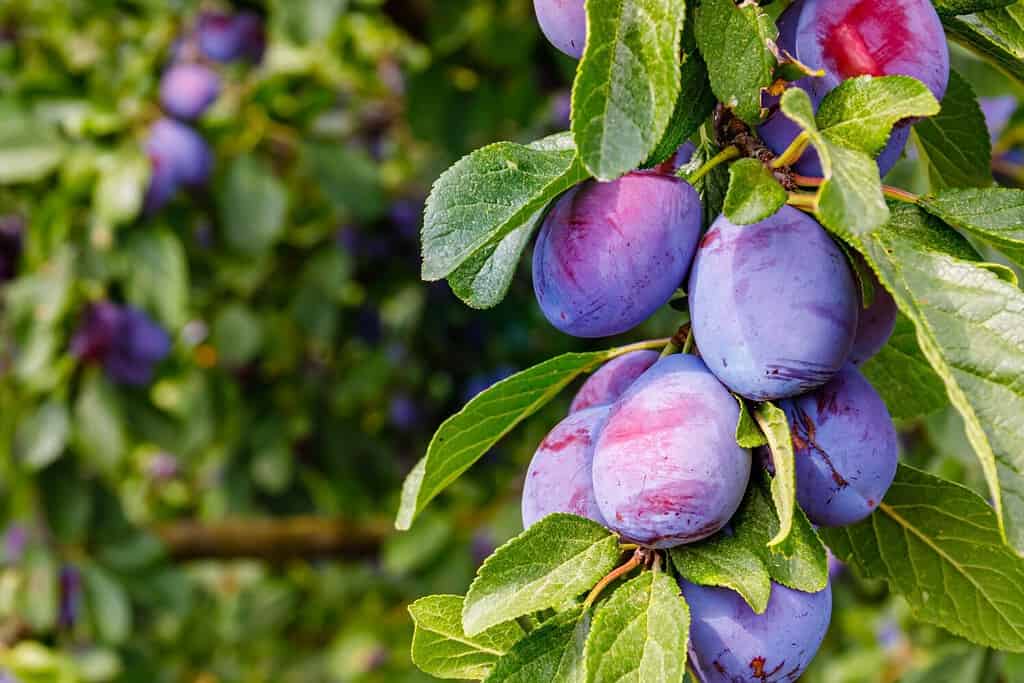
Plum trees can live up to 50 years in the right conditions!
©nnattalli/Shutterstock.com
Numerous plum tree varieties thrive in Virginia, with some being capable of self-pollination.
The fruit of the plum tree comes in colors ranging from deep purple and red to sunny yellow and green. Typically maintaining a compact stature, plum trees usually grow no taller than about 16 feet and span an approximate width of 13 feet.
When planting a plum tree, select a site with loamy, permeable soil, as plums tend to struggle in clay-rich grounds or in spots where their roots remain perpetually damp. The optimal site would be one that enjoys a generous amount of sunlight, with a daily minimum of 6 to 8 hours of unfiltered sun exposure.
In particular, the yellow gold variety exhibits rapid growth and yields some of the most succulent and sweetest plums when allowed to mature on the tree. Meanwhile, the Stanley variety, with its purplish-blue hue, stands resilient in the colder mountain regions of Virginia.
12. Fig Tree (Ficus carica)
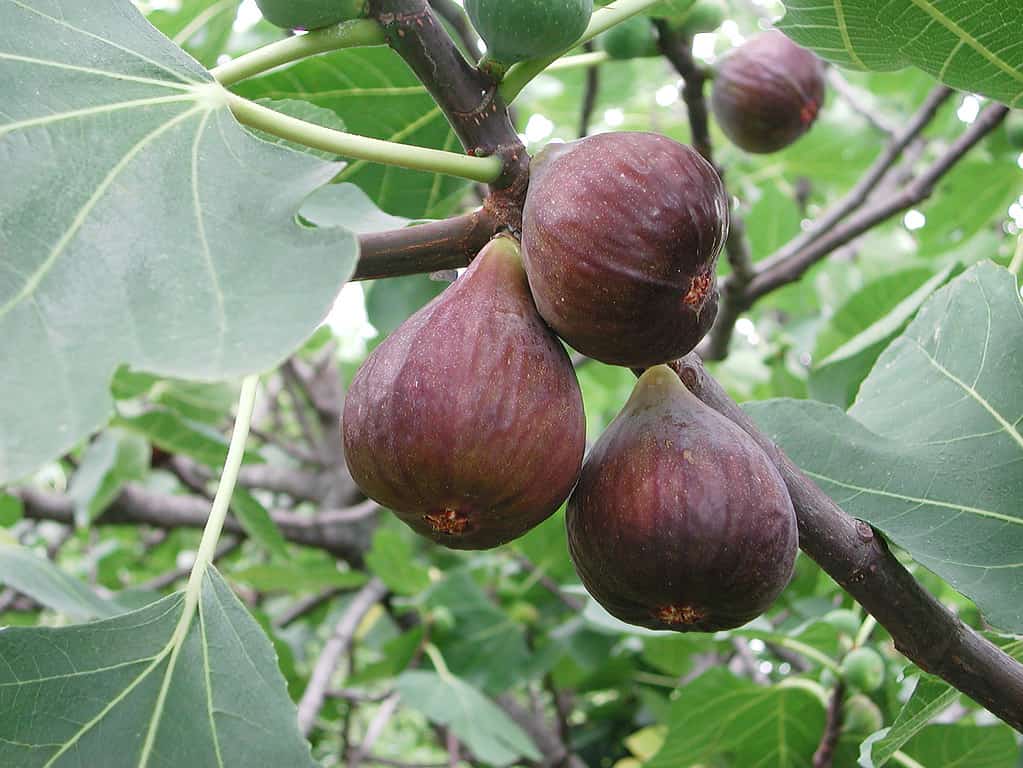
Most fig trees desire warmer conditions than Virginia has to offer, but there are some hardy varieties that can survive in the state.
©simona pavan/Shutterstock.com
Fig trees can flourish in Virginia, but most varieties will only grow in the warmest regions of the southeast as figs thrive in hardiness zones 8 to 10. That said, there are a few hardy varieties of fig trees that can thrive across the state.
The fig tree is known for its expansive leaves, which feature three to five pronounced lobes. The tree bears a distinctive fruit characterized by its pear-like shape. Measuring about 1 to 2 inches in length, the fruit showcases a green exterior that may transition to shades of purple or brown as it matures, encasing a sweet, red interior.
It’s critical to ensure that the chosen location receives plenty of warm sunshine, as the fruits rely on this to reach a ripe state.
Recommended fig varieties that adapt well to Virginia’s conditions are Celeste, Hardy Chicago, Brown Turkey, Violet de Bordeaux, and Panache.
13. Peach Tree (Prunus persica)
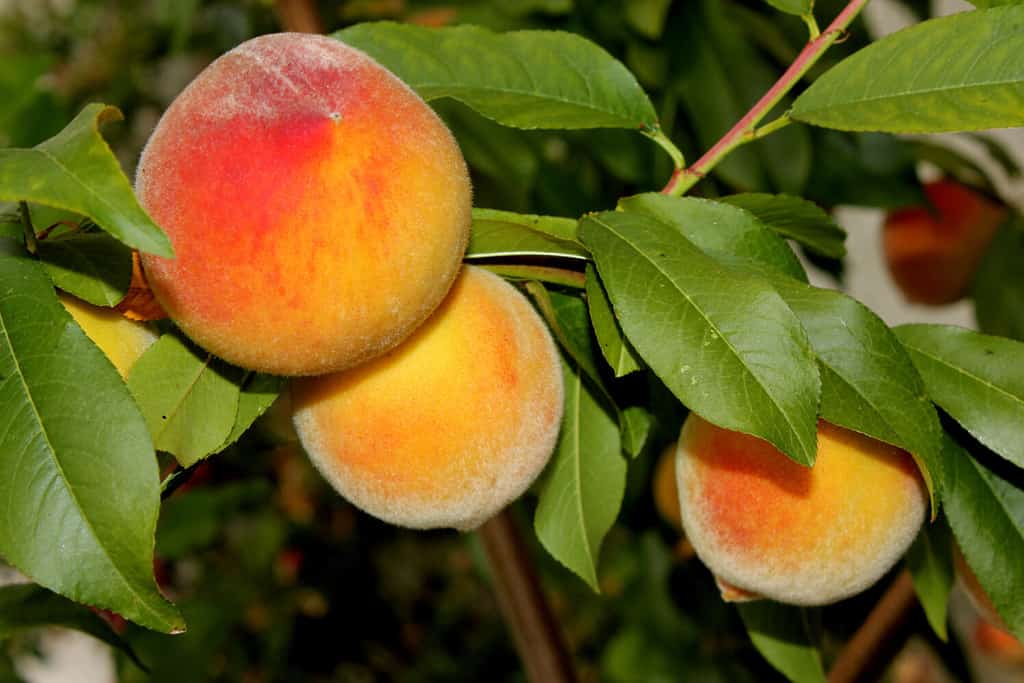
The weather conditions in Virginia are perfect for peaches, making the state one of the best for the fruit.
©Gurcharan Singh/Shutterstock.com
Virginia presents an ideal environment for growing peach trees. With the right location and care, one can expect a tree to thrive for two to three decades. Much of Virginia provides the perfect conditions for peach trees as they produce the most fruit in hardiness zones 6 to 8.
Characterized by its squat and expansive structure, a peach tree typically reaches heights between 15 and 25 feet. The tree showcases a spherical canopy, with branches stretching towards the sky, adorned with dark green, sheddable leaves spanning three to six inches. Peaches are a juicy, sweet fruit wrapped in soft, velvety, and effortlessly peelable skin.
To prosper, peach trees demand a generous amount of sunshine, unhindered by shadows cast from structures. Selecting a site that is elevated is advantageous, as it prevents cold air from settling around the tree during frosty nights in the blooming season.
A notable variety in Virginia is the Elberta, holding a prominent position in the commercial sector. This type demonstrates a remarkable adaptability to diverse soil types and weather conditions prevalent in the region.
14. Apple Tree (Malus domestic)
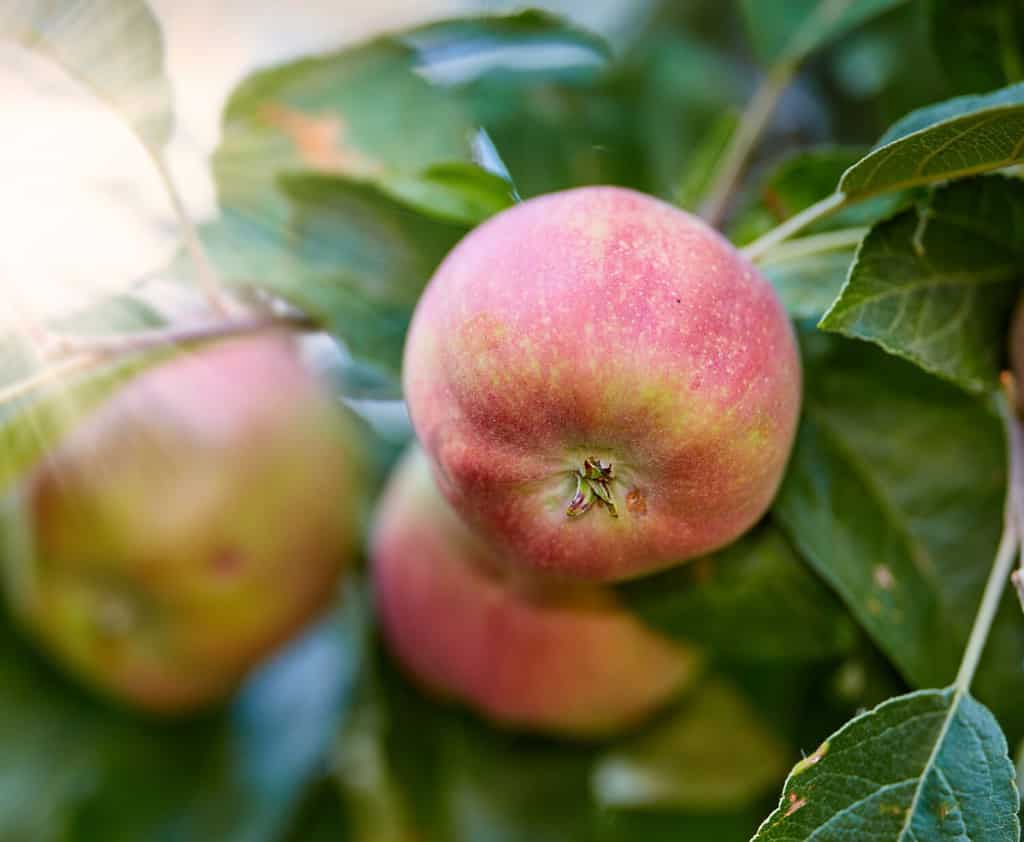
Apples are one of the top 10 most valuable crops grown in Virginia.
©PeopleImages.com – Yuri A/Shutterstock.com
Virginia ranks in the top 10 states for apple cultivation, so it goes without saying that apple trees thrive in the state. In fact, you can find approximately 25 distinct varieties of apples in Virginia!
The apple tree, relatively small in stature, grows to a maximum of 25 feet. Apples predominantly display a color palette of red, green, and yellow.
These trees prefer locations bathed in ample sunlight, protecting them from lingering cold snaps that can jeopardize the blossoms. Typically, they flourish in expansive open areas like lawns or are skillfully cultivated to sprawl flat against supporting structures like walls or fences. It’s vital to select a spot offering well-draining conditions, with sandy loam soils being the most favorable choice.
Among the widely favored varieties, one can find the Golden Delicious, Red Delicious, Rome, Gala, York, Granny Smith, Fuji, and Ginger Gold.
15. Quince Tree (Cydonia oblonga)

While quince fruit looks similar to pears, they are not often eaten raw and are more commonly cooked into jams or desserts.
©darksoul72/Shutterstock.com
Quince trees thrive in Virginia due to the region’s USDA zone compatibility, though they might require a little extra care in the colder zones of the state.
These plants, often resembling shrubs or small trees, possess smooth leaves accompanied by tiny leaf-like protrusions near the base. Their large, singular blossoms, ranging from pure white to soft pink, resemble apple and pear flowers, but with noticeable leafy structures surrounding the base and a multi-sectioned core.
Quince trees benefit from nutrient-rich, moisture-holding soils. Due to their early blossoming nature, selecting a warm and sheltered location with ample sunlight is crucial to safeguard against frost and assist the fruit in maturing.
For those looking to plant in Virginia, consider these quince varieties: Aromatnaya, Cooke’s Jumbo, Kuganskaya, and Smyrna.
Summary of 15 Best Fruit Trees That Grow In Virginia
| Fruit Tree | Botanical Name | |
|---|---|---|
| 1 | Gooseberry Tree | Phyllanthus acidus |
| 2 | Mulberry Tree | Morus |
| 3 | Elderberry Tree | Sambucus |
| 4 | Persimmon Tree | Diospyros virginiana |
| 5 | Pear Tree | Pyrus |
| 6 | Apricot Tree | Prunus armeniaca |
| 7 | Crabapple Tree | Malus |
| 8 | Serviceberry Tree | Amelanchier |
| 9 | Cherry Tree | Prunus |
| 10 | Nectarine | Prunus persica var. nucipersica |
| 11 | Plum Tree | Prunus domestica |
| 12 | Fig Tree | Ficus carica |
| 13 | Peach Tree | Prunus persica |
| 14 | Apple Tree | Malus domestica |
| 15 | Quince Tree | Cydonia oblonga |
The photo featured at the top of this post is © Mr.Somchai Sukkasem/Shutterstock.com
Thank you for reading! Have some feedback for us? Contact the AZ Animals editorial team.







